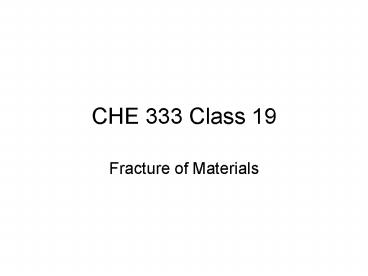CHE 333 Class 19 PowerPoint PPT Presentation
1 / 17
Title: CHE 333 Class 19
1
CHE 333 Class 19
- Fracture of Materials
2
Ductile or Brittle Failure
- Following elastic deformation, two different
- processes can occur plastic deformation
- leading to ductile failure or movement to
- brittle fracture with little or no plasticity.
- The stress strain curve is shown for ductile
- failure. After the UTS the ductility is shown
- by the necking of the material. This would
- only be for round bar.
- The stress strain curve for brittle materials
- is indicated, which would be for glass and
- ceramics.
Brittle Failure SvS stops here
3
Fracture Processes
Ligament of material Stretches between voids
- For ductile materials which have plasticity
- once the neck starts, a sequence of
- structural changes occurs as the metal
- proceeds to failure. Internally voids are
- initiated . Both the true stress and strain
- are both still increasing. With further
- increase in strain the voids become
- larger, as they become circular or
- ellipsoidal in shape. The small ligaments
- of metal between the voids eventually
- tears and an internal crack is initiated.
- With further true stress and strain increase
- the last areas to fail are those connecting
- the internal crack to the surface. A shear lip
- at 45o to the surface characterizes this region
- leading to cup and cone fracture in rod.
4
Micro Failure Processes.
- In single phase materials, small voids appear
- at the cell walls as each dislocation effectively
- carries a vacancy with it. These voids then
- grow with further stressing
5
Micro Failure Processes
- In two phase material, several different
- micro processes can lead to void initiation
- growth and failure.
- If the second phase is either large or
continuous, - then a dislocation pile up in one phase will lead
- to a void formation. This will then grow in
- phase. The second phase will have strengthened
- the material but will also have eventually
- initiated the failure process.
- Examples include pearlitic steels and
- other platelet structures such as those
- in titanium alloys
Second Phase
45o
Void from dislocation pile up on slip plane
s
6
Micro Failure Example
Example of toughened material?
7
Micro Failure Processes
- When the second phase is small and
- non discontinuous, other processes in
- addition to dislocation pile up and a void
- on the slip plane are possible. The controlling
- factors are the strength of the second phase
- particle and interface between the second
- phase and the matrix material.
- If the second phase is weaker or more
- brittle than the matrix, then the second phase
- particle may crack.
- Age hardened aluminum alloys behave in
- this manner
8
Micro Failure Example
Al 7079 Age Hardened alloy showing particle
failure.
9
Micro Failure Examples
10
Macro View of Failure
11
Fracture Surface Features
Ductile failure in a titanium alloy which is two
phase showing dimples from void formation
12
Final Failure in Shear Lip
Shear dimples in area of shear lip.
13
Brittle Failure Fracture Surface
A faceted type of fracture surface is often seen
with a brittle failure as cracks are on a
single crystal plane, no shear lip would be
found..
14
Fracture Mechanics.
- Originally to explain why glass has low toughness
where toughness if the ability to resist crack
growth - in a material.Simple energy balance used energy
applied is the stress and it is used up by - creating fresh surface. Works well for brittle
materials where no plastic deformation. For
ductile - materials energy absorbed is complicated by
plastic deformation. Fracture mechanics relates
the size - of a defect in the material to the stress is can
withstand before failure. -
Kc Ysc (pa)0.5
I
II
Mode
III
15
Plane Strain Fracture Toughness
16
Ductile to Brittle Transition
- In some materials, mainly steels, ductility can
decrease very sharply with temperature, so a
ductile - materials becomes brittle know as the ductile
brittle transition. The standard test is to use
an impact - tester a pendulum type hammer and the energy
absorbed in failure is measured by how far the - hammer swings through after impact the further
the less energy.
Shear ratio to impact energy
Carbon content effect on DBTT for Steels
17
Homework
- For a material with a single crystal yield
strength of 300 MPa, calculate the yield strength
for a grain size of 50 micron and for a grain
size of 2.5 microns. Assume k 1 - Decide the crack initiation process in a tensile
test for the following conditions- - Matrix shear strength Matrix Normal Strength
Interface Strength Particle Strength - a 25 60 35 55
- b 55 50 60 60
- c 55 60 35 45
- d 45 55 45 35
- Data units MPa.

